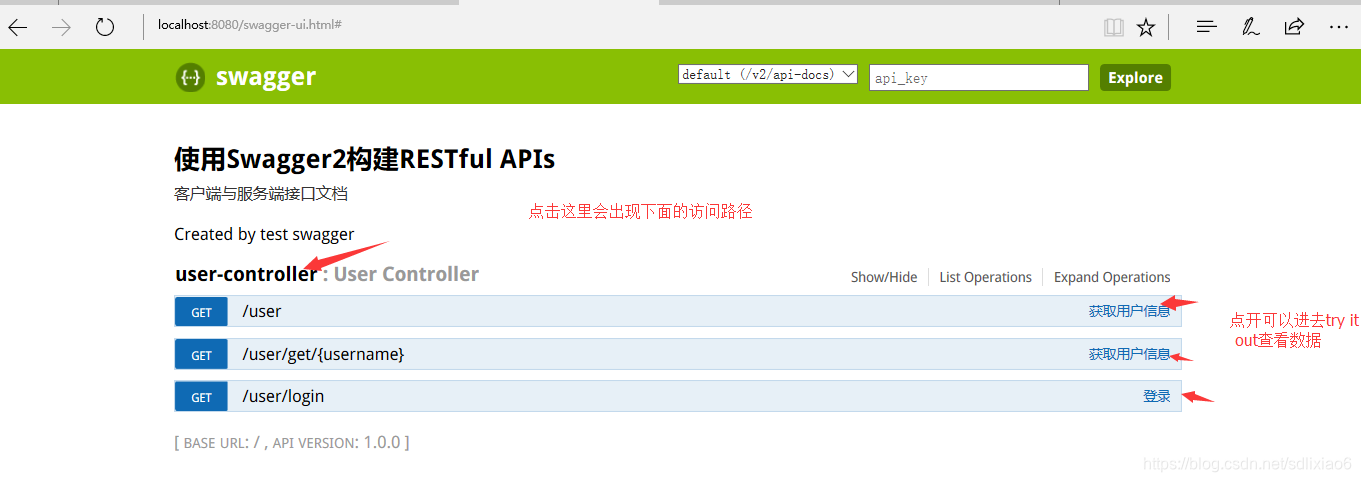1.在pom.xml中添加添加Swagger2依赖
<!--swagger2 依赖开始-->
<dependency>
<groupId>io.springfox</groupId>
<artifactId>springfox-swagger2</artifactId>
<version>2.2.2</version>
</dependency>
<dependency>
<groupId>io.springfox</groupId>
<artifactId>springfox-swagger-ui</artifactId>
<version>2.2.2</version>
</dependency>
<!--swagger2 依赖结束-->
2.在服务启动类的同级创建Swagger2配置类SwaggerConfig
package com.study.model;
import org.springframework.context.annotation.Bean;
import org.springframework.context.annotation.Configuration;
import springfox.documentation.builders.ApiInfoBuilder;
import springfox.documentation.builders.PathSelectors;
import springfox.documentation.builders.RequestHandlerSelectors;
import springfox.documentation.service.ApiInfo;
import springfox.documentation.spi.DocumentationType;
import springfox.documentation.spring.web.plugins.Docket;
import springfox.documentation.swagger2.annotations.EnableSwagger2;
@Configuration
@EnableSwagger2
public class SwaggerConfig {
@Bean
public Docket createRestApi() {
ApiInfo apiInfo = new ApiInfoBuilder()
.title("使用Swagger2构建RESTful APIs")
.description("客户端与服务端接口文档")
.termsOfServiceUrl("http://localost:8080")
.contact("test swagger")
.version("1.0.0")
.build();
return new Docket(DocumentationType.SWAGGER_2)
.apiInfo(apiInfo)
.select()
.apis(RequestHandlerSelectors.basePackage("com.study.model"))
.paths(PathSelectors.any())
.build();
}
}
注意: 上面的包名是对应工程的包 我的包是这样的

上述代码中,通过@Configuration注解,让Spring来加载该类配置,通过@EnableSwagger2注解来启用Swagger2。
再通过createRestApi函数创建Docket的Bean之后,apiInfo是用来创建接口文档的基本信息(这些基本信息会展现在文档页面中)。select()函数返回一个ApiSelectorBuilder实例用来控制哪些接口暴露给Swagger来展现,本例采用指定扫描的包路径来定义,Swagger会扫描该包下所有Controller定义的API,并产生文档内容(除了被@ApiIgnore指定的请求)。
3.给对应API接口创建描述信息
package com.study.model.controler;
import io.swagger.annotations.ApiImplicitParam;
import io.swagger.annotations.ApiImplicitParams;
import io.swagger.annotations.ApiOperation;
import org.springframework.web.bind.annotation.*;
@RestController
@RequestMapping(value="/user")
public class UserController {
@ApiOperation(value="获取用户信息", notes="欢迎用户")
@RequestMapping(method = RequestMethod.GET)
public String user(){
return "hello world!";
}
@ApiOperation(value="获取用户信息", notes="根据{username}获取对应用户信息")
@RequestMapping(value="/get/{username}",method = RequestMethod.GET)
public String get(@PathVariable("username") String username){
return "welcome," + username;
}
@ApiOperation(value="登录", notes="根据URL中的username、pwd进行用户登录验证")
@ApiImplicitParams({
@ApiImplicitParam(name = "username", value = "用户名", required = true,paramType = "query", dataType = "string"),
@ApiImplicitParam(name = "pwd", value = "密码", required = true,paramType = "query", dataType = "string")
})
@RequestMapping(value="/login",method = RequestMethod.GET)
public String login(@RequestParam String username, @RequestParam String pwd){
return "user:" + username + ",password:" + pwd;
}
}
4.运行后,访问 http://localhost:8080/swagger-ui.html 就能 看到之前所展示的RESTFUI API的页面








 本文详细介绍了如何使用Swagger2在Spring Boot项目中搭建RESTful API文档,包括添加依赖、配置Swagger、创建API描述信息及查看效果。通过具体代码示例,帮助读者快速上手。
本文详细介绍了如何使用Swagger2在Spring Boot项目中搭建RESTful API文档,包括添加依赖、配置Swagger、创建API描述信息及查看效果。通过具体代码示例,帮助读者快速上手。
















 856
856

 被折叠的 条评论
为什么被折叠?
被折叠的 条评论
为什么被折叠?








